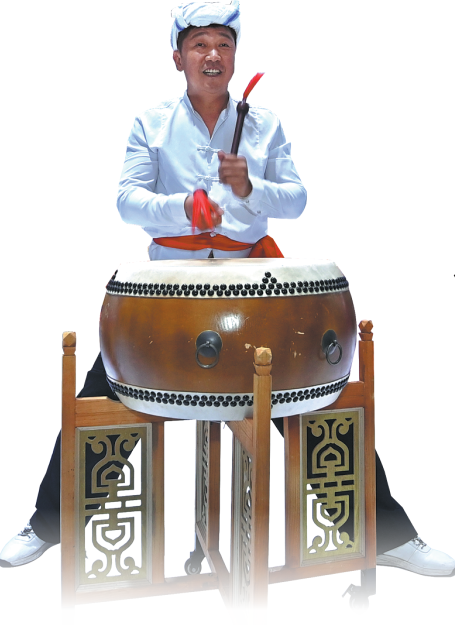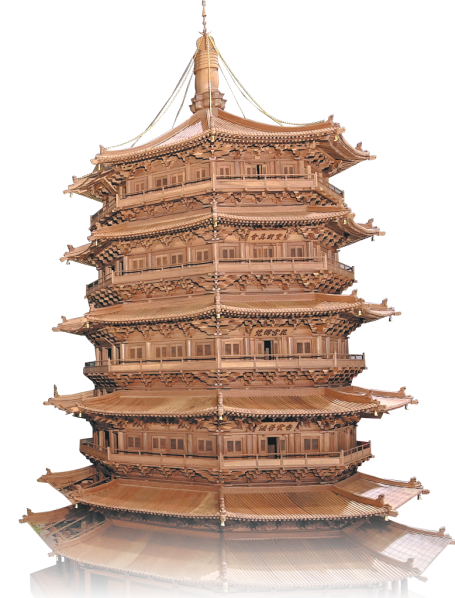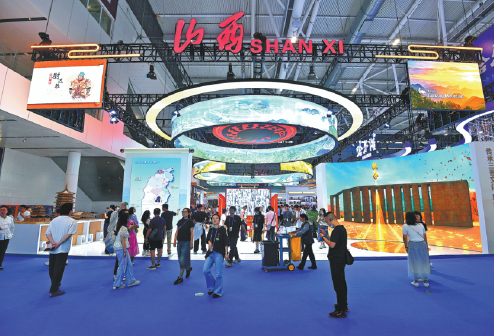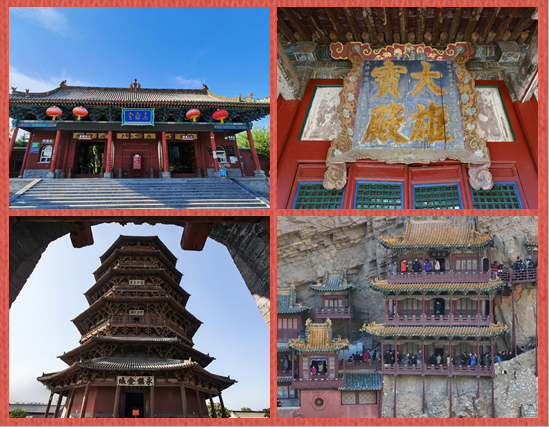Shanxi culture shines at industries fair
Updated: 2025-06-03
Display of province's unique heritage and rich history impresses visitors at Shenzhen-based event
As one of the cradles of Chinese civilization, the province of Shanxi showcased its rich cultural resources and development achievements of the cultural industry at the recently concluded 21st China (Shenzhen) International Cultural Industries Fair.
The event was held from May 22-26 in the metropolis of Shenzhen in South China's Guangdong province.
The Shanxi pavilion covered an area of 756 square meters. The most eye-catching part of Shanxi's exhibition is a huge display screen on the right side of the pavilion, featuring an ancient observatory of the Taosi relics site in Shanxi's Linfen city.
The Taosi relics site was discovered in 1958. Over the past decades, more than 5,500 relics have been unearthed. With city ruins of an unprecedented scale and multiple functional zones, palaces and tombs of clearly defined hierarchies, the site is among the major ruins of capital cities in the early stages of Chinese civilization more than 4,000 years ago.
At the Taosi relics site, archaeologists also discovered the earliest observatory known in China. The video display during the Shenzhen expo explained how this ancient observatory works.
The video showed that the observatory comprised 13 rammed earth columns arranged in a semicircular shape. Standing at a specific observation point, observers could determine the solar terms based on the position of the sun during sunrise. For example, the winter solstice occurs when the sun rises from the second narrow gap between the columns, while the spring and autumn equinoxes are marked by the seventh gap.
The establishment of 24 solar – or zodiac – terms is believed to be an outstanding contribution to the world made by ancient Chinese almanac scientists.
The system of the zodiac, used by Chinese people to guide agricultural production in both ancient and modern times, was recognized as an intangible cultural heritage item by UNESCO in 2016.
The discovery of the ancient observatory at the Taosi relics site proved that the system was in place some 4,000 years ago. This site also shows that Shanxi is one of the origins of Chinese civilization.
Evidence of Shanxi's importance in shaping the culture of China is also demonstrated in its great number of tangible and intangible cultural heritage items.
The province has 53,875 unmovable cultural heritage items, with 531 on the national list of protection. Both numbers rank it first among all the provincial-level regions in China.
These cultural assets include 28,027 preserved ancient architectural structures, including 509 built during and before the Yuan Dynasty (1271-1368).
On another screen on the left side of the Shanxi pavilion, a map of Shanxi's cultural resources was displayed.
Themap highlighted Shanxi's three World Cultural Heritage Sites – Pingyao ancient city in Jinzhong city, Yungang Grottoes in Datong city and Mount Wutai in Xinzhou city; and China's only three preserved wooden structures built in the Tang Dynasty (618-907) – the main halls of Nanchan Temple and Foguang Temple in Wutai county and the main hall of Guangrenwang Temple in Ruicheng county.
There were also wooden models of the famed ancient structures, including the main hall of Foguang Temple, the Sakyamuni Pagoda in Yingxian county and the Stork Tower in Yongji city, with cross sections to show the details of their interior details.
Li Wei, a visitor from Guangdong province, said he was amazed with the structural details of the Sakyamuni Pagoda, which is also known as the Yingxian Wooden Pagoda.
"I visited the Yingxian Wooden Pagoda years ago," Li said. "But this offers a rare chance to have a close-up observation of its structural details."
He said the complicated structural design featuring 59 kinds of bracket sets that channel the weight from the roof to the columns and buffer and transport the impact from any outside force makes it an architectural miracle in China and in the world.
Built in the Liao Dynasty (916-1125), the Yingxian Wooden Pagoda often ranks alongside the Leaning Tower of Pisa and the Eiffel Tower in Paris. It is the world's oldest and tallest wooden pagoda, a testament to ancient China's architectural mastery and a perfect fusion of Buddhist culture and art.
Shanxi's other attractions – including the Great Wall, the Yellow River and the Taihang Mountains, and the introduction of Shanxi's history, were featured on two display screens hanging above the entrance of the Shanxi pavilion.
During the expo, Shanxi showed that its cultural assets are still alive in modern times and in people's daily life.
Some of the folk arts from Shanxi are performed on the site of the Shanxi pavilion, giving audience members a chance to experience the traditions and customs unique to the province.
On May 24, visitors gathered at the pavilion to enjoy a weifeng luogu show.
Weifeng luogu, which literally means "awe-inspiring gong and drum", is a traditional percussion performance in Shanxi province involving such instruments as gongs, drums and cymbals. In Shanxi, weifeng luogu performance is usually presented as a contest among teams. It is widely used in weddings and traditional festivities to bring good fortune.
The show secured the loudest applause from the audience.
"As its name suggests, the performance is really awesome," said a visitor surnamed Li, who was from Zhuhai, Guangdong province. "The powerful rhythm is fascinating. You can't help wanting to join in and dance."
A Puju Opera show was another highlight of that day's performances.
Puju Opera, also called Puzhou Bangzi, is a local opera form popular in the city of Yuncheng and its neighboring areas in Shanxi and Shaanxi provinces. With a history dating back to the Song Dynasty (960-1279), Puju Opera is sometimes referred to as the "living fossil of China's opera art".
It is said Puju is one of the sources of the opera performing skill of "flowing sleeve", which is also popular in many Chinese opera varieties.
At the Shenzhen expo show, an opera enthusiast from Shenzhen said she saw the best flowing sleeve performance from these Shanxi artists. "When the actresses dance with flowing sleeves, it reminds me of the flowing clouds and running water," she said.
The day's shows also included a suona horn performance by an artist from Jixian county, folk songs from Xiangning county and yingge dance by artists from Huozhou city.
In addition to displaying its cultural and tourism resources, Shanxi also showcased its creative cultural products at the Shenzhen expo.
Zhang Yu, a visitor from Qinghai province, for instance, was attracted to an artificial intelligence photography workshop at the Shanxi pavilion on May 25.
The workshop was established by Shanxi Publishing Media Group, which allows visitors to have their photos integrated with Shanxi's landmark cultural attractions in an interactive manner with the help of AI.
Zhang was especially satisfied with a picture featuring clapping hands with a Buddha statue of the Yungang Grottoes, a treasure trove of Buddhist cave art in Datong city.
Hua Mulan, the ancient Chinese female warrior recently known to the world thanks to the Disney movie Mulan, this time became an image ambassador and a tour guide of the city of Datong.
This humanoid robot with a 3D-printed body, has a great resemblance to human beings in terms of appearance, skin, voice and motion. She answered visitors various questions about the history, culture and tourism attractions of Datong.
The most frequently asked question from visiting children was "Is Mulan really a Datong native?"
The robot's answer was that the household narrative poem of Hua Mulan was created during the Northern Wei Dynasty (386-534). Datong, then called Pingcheng and serving as the capital of the regime, has many legends relating to this figure. "Mulan is an idol for all the Chinese people," it said.
During the five-day event, various cities from Shanxi also displayed their own cultural and tourism attractions.
The city of Yuncheng, for instance, displayed its cultural assets relating to legendary and historical figures shaping the civilization and culture of China, including the three sacred emperors of Yao, Shun and Yu some 4,000 years ago, as well as Houji and Leizu, the pioneers of China's farming and silk production industries respectively. Its renowned cultural relics, like the Temple of Guandi, Yongle Palace and Pujiu Temple, were also showcased.
About 40 enterprises from Shanxi exhibited their creative products inspired by intangible cultural heritage and made with traditional techniques.
These products included pearl-inlaid lacquerware from Jishan county, eight-colored porcelain from Changzhi city, hand-polished lacquerware from Pingyao county, ironware from Zezhou county and bronzeware from Datong city.
Zhang Qi contributed to this story.

A weifeng luogu show is staged at the Shanxi pavilion. WANG RUIRUI/FOR CHINA DAILY

A wooden model of the Yingxian Wooden Pagoda is displayed at the Shanxi pavilion. WANG RUIRUI/FOR CHINA DAILY

Shanxi's cultural and tourism attractions are displayed at the 21st China (Shenzhen) International Cultural Industries Fair. WANG RUIRUI/FOR CHINA DAILY

From left: A representative from Huozhou city introduces local creative cultural products to visitors. An overseas visitor shows interest in Shanxi's porcelain products. The Shanxi pavilion attracts flocks of visitors during the 21st China (Shenzhen) International Cultural Industries Fair. WANG RUIRUI/FOR CHINA DAILY



